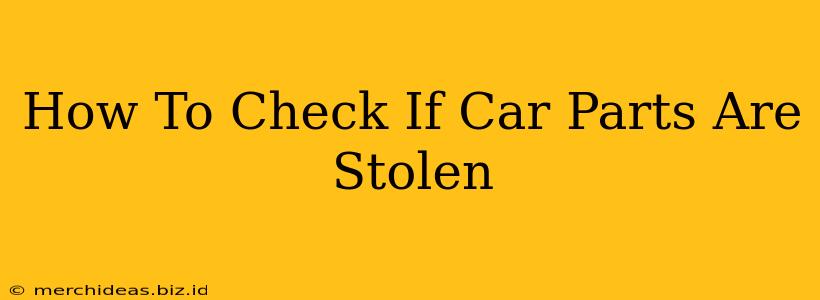Buying used car parts can save you a significant amount of money compared to buying new from a dealership. However, it's crucial to be aware of the risk of purchasing stolen parts. Buying stolen goods is illegal and can lead to serious consequences. This comprehensive guide will walk you through several methods to check if car parts are stolen before you buy them.
Why is it Important to Check for Stolen Car Parts?
Purchasing stolen car parts can have several serious repercussions:
- Legal Ramifications: You could face legal charges for possessing stolen property, even if you weren't aware of the theft.
- Financial Losses: You may lose the money you spent on the parts, and potentially face further costs if the parts are seized.
- Safety Concerns: Stolen parts may be damaged or improperly repaired, posing a safety risk to you and others.
- Ethical Concerns: Supporting the theft of car parts contributes to a larger problem affecting the automotive industry and legitimate businesses.
Effective Ways to Verify the Legitimacy of Used Car Parts
Here's a breakdown of steps you can take to minimize the risk of purchasing stolen car parts:
1. Source Your Parts from Reputable Sellers:
- Established Businesses: Opt for established businesses with a solid reputation and positive reviews. Dealerships and reputable auto part stores are less likely to sell stolen parts.
- Online Marketplaces with Seller Verification: Some online marketplaces have verification processes for sellers, offering a degree of protection. Always check seller ratings and reviews.
- Avoid Suspiciously Low Prices: A price significantly below market value should raise a red flag. If it seems too good to be true, it probably is.
2. Scrutinize the Documentation:
- Request Documentation: Legitimate sellers should be able to provide documentation proving the origin of the parts. This might include receipts, invoices, or certificates of ownership.
- Verify VIN Numbers: For major parts like engines or transmissions, check the Vehicle Identification Number (VIN) etched onto the part against the documentation. Any discrepancies should raise concern.
- Check for Tampering: Examine the documentation carefully for signs of alteration or forgery.
3. Inspect the Parts Carefully:
- Physical Condition: Look for damage that isn't consistent with normal wear and tear. Significant damage or poorly executed repairs could be signs of a salvaged or stolen part.
- Part Numbers and Markings: Ensure the part numbers match the documentation and are not altered or erased.
- Unusual Features: Be wary of parts with missing or altered identification markings.
4. Use Online Databases (When Applicable):
- National Insurance Crime Bureau (NICB): While the NICB doesn't have a public database for individual parts, they are a valuable resource for reporting stolen vehicles and parts. If you suspect a part is stolen, you can report it to them.
- Local Police Departments: Contact your local police department if you suspect you've purchased stolen parts. They might have information regarding recently reported thefts in your area.
5. Consider Professional Inspection:
- Certified Mechanics: If you're unsure, consider having a certified mechanic inspect the parts before installation. A mechanic with experience can often identify signs of tampering or damage that might indicate a stolen part.
Conclusion:
Purchasing used car parts can be a cost-effective way to maintain your vehicle, but it's vital to prioritize caution. By following these steps and remaining vigilant, you can significantly reduce the risk of inadvertently buying stolen car parts and avoid the legal and financial consequences that can follow. Remember, a little extra diligence can save you a lot of trouble in the long run.
